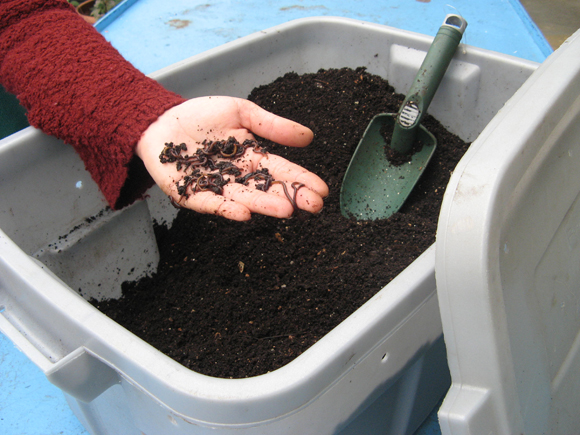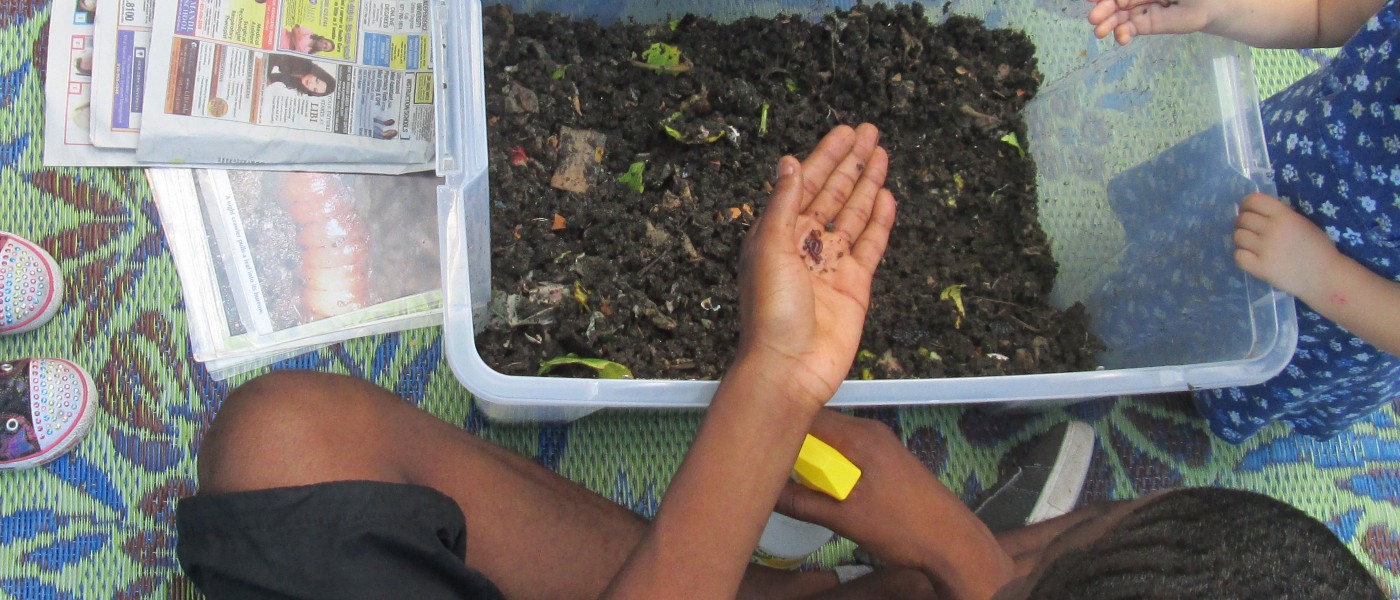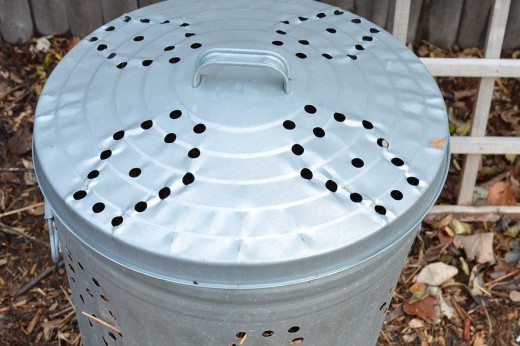"People have shared with me that composting their garbage with worms makes them feel good. They like turning the most repulsive part of their trash into something useful."
—Mary Appelhof, Worms Eat My Garbage
You can use redworms to recycle your food waste by setting up a worm bin system at home. Redworms transform soil and decaying plant material into an excellent soil amendment and conditioner called vermicompost. Your food waste will disappear and your plants will flourish!
Indoor composting is perfect for apartment dwellers or those without access to outdoor space. It’s a great entry-level project for first-time composters, because the setup is minimal and it’s easy to start over if things go awry. Kids in particular love putting worms to work, and the process offers a compelling window into the natural world and the cycle of life and decay.
Besides making your garden greener, vermicomposting will help you reduce the waste you put out in the trash, both in volume and frequency. When you don’t have rotting, smelly food in your waste can, you don’t need to empty it so often. Worm bins themselves are mostly odorless.
“Some people worry that indoor composting is ‘dirty’,” says Karla Osorio-Pérez, community greening manager at BBG. “But what happens in the bin stays in the bin. There’s already bacteria all over our kitchens! What we should be worrying about is what we put in the trash.”
Starting a System
It’s easy to build your own vermicompost bin from a plastic storage container. To determine the size of your container, consider where you will store the bin and the quantity of scraps you anticipate processing each week. The bin should be about a foot deep and needs one square foot of surface area to accommodate about three pounds of scraps in a week—size up accordingly. It should be covered and stored in a dark, relatively undisturbed area such as a closet or under your sink with a temperature of 55–75°F. Drill plenty of ventilation holes in the cover and the upper few inches of the sides. You can add screen to keep houseflies out (and worms in!) but it’s usually not necessary.

Fill the bin with about eight inches of light, organic bedding such as shredded newspaper, leaves, or coir. (You’ll want to keep a supply of extra bedding on hand to add to the bin later.) Mix in a handful of soil to provide grit and bacteria to aid the worms’ digestion. Wet the bedding material until it is damp but not dripping—it should feel like a wrung-out sponge. If your system becomes too wet the worms can drown or try to flee to safety, and the bin might get smelly. If it’s too dry, the worms will dehydrate and die. Be sure to carefully monitor the system’s moisture and add dry material or mist as appropriate.
Feed your worms fruits and vegetables, breads and grains, eggshells, coffee grounds, and even teabags (tear off the staple). Leave out meats and oily materials, and learn what your worms eschew (you’ll want to limit quantities of citrus and spicy foods). Chop bulky items into smaller pieces to provide greater surface area. You can compost a small amount of food scraps at a time or larger amounts less frequently. To avoid odors while you’re collecting scraps, you can store them in the fridge.
Which Worms?
Indoor systems employ redworms, which are different from nightcrawlers and other garden worms. You can order worms from a supplier (see resources); you will usually receive Eisenia fetida or Lumbricus rubellus. These species don’t develop extensive burrowing systems, so they don’t mind being moved around. They’re effective workers, consuming half their body weight in organic matter each day! You’ll want about one pound of worms per square foot of surface area in your bin.
Worms don’t have teeth, so they don’t chew their food. They do, however, have a gizzard, where pieces of soil and grit lodge and help grind down the size of food particles. Bacteria and protozoa also help break down organic matter before it reaches the intestinal tract. Worms egest undigested organic matter, soil, and bacteria as worm castings, an extremely rich soil amendment that contains ten times the amount of nitrogen as traditional compost.
Before adding worms to your bin, move it to a brightly lit location. Bury some food in one spot at the bottom of the bin. Shake the worms onto the bedding and leave the cover off. Redworms dislike light and will burrow away from it; after a few hours, cover the bin and move it to the location you selected.
Maintaining the System
Each time you bury scraps, you should select a new spot. Cover the scraps with new, dry bedding material. Worms will eat the bedding and food scraps and produce vermicompost, a mixture of decomposed bedding and worm castings. The volume of bedding will decrease as it is consumed; add more material as needed. The worm activity will aerate the bedding, but you may want to fluff it up every week or so. Maintenance is super easy: Just feed your worms, keep the bedding moist but not damp, and watch for signs of worm activity.
In a vermicompost system, your worm population is self-regulating. Worms will breed when conditions are comfortable and food is plentiful. They are hermaphrodites, having both male and female reproductive organs; when they breed with each other each worm will develop a cocoon that then hatches a set of one to three baby worms. Worms can reproduce every three months and live for years, so you can imagine how rapidly the population will grow! When food is scarce, worms die off. Their bodies decompose very quickly, releasing nitrogen and other nutrients.
After a few months, when the bedding starts to look dark and crumbly, the vermicompost is ready to harvest. If you want to start a second bin, you can sift the worms from your finished compost using a wire mesh screen then add them to the new container. Or you can push the vermicompost to one side of your existing bin and add new bedding and food scraps along the other side. Keep the two sides from mixing, and the worms will move over to the fresh bedding. Within a month, most of the worms will have moved over and you can scoop out the finished vermicompost.
Vermicompost offers an excellent mix of nutrients and a useful culture of beneficial microorganisms. Use it as top dressing or in soil mixes, or throw a handful (worms and all!) in with transplants. Isn’t it better in your garden than in your garbage?
Troubleshooting
Worms aren’t the only critters at work in your bin. Mites, snails, spiders, ants, and even (ick) maggots are part of the natural soil food web. Remember that worms and their fellow organisms do their business in the bin—it doesn’t contaminate your living space. Sometimes, though, the system can get out of balance. If things go far awry and you have strong odors or worm die-off, it might be best to dump out your bin in the garden and start over, having learned from your mistakes.
Problems & Solutions
Odor
- Aerate the bedding
- Avoid noxious scraps
- Make sure food is buried
- Add food less frequently
Scraps don’t break down
- Check that your worms are still alive and active
- Chop scraps into smaller pieces
- Avoid spicy foods
Worms are dying
- Keep temperature 55–75°F
- Check moisture level; add dry bedding or mist as needed
- Add more ventilation
- Avoid citrus scraps
- Add food, unless food is not being consumed (in which case, add less)
Worms are trying to escape
- Check moisture; add dry bedding if too wet
- Make sure they have adequate food
- Put bin under a light to encourage burrowing in
Too many worms!
- Help a friend start a bin with the extra worms
- Let them die back on their own
Ants
- Be sure to bury food
- Add screen over ventilation holes
Mites
- Remove and discard any mite-covered scraps
Fruitflies
- Be sure to bury food
- Add dry bedding
- Wash fruit peels (or avoid composting them)
- Use fruit fly traps
Resources
Worms Eat My Garbage, Mary Appelhof
Flowerfield Enterprises, 1997 (2nd Edition)
The bible of vermicomposting
Easy Compost, Niall Dunne, editor
Brooklyn Botanic Garden, 2013
Includes a chapter on how to set up a worm bin.



